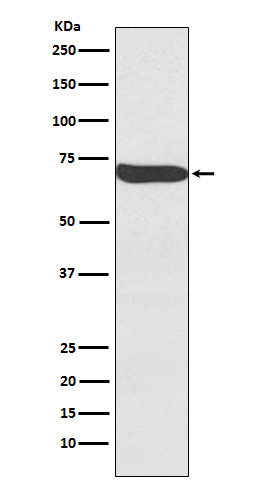
| WB | 1/1000-1/2000 | Human,Mouse,Rat |
| IF | 咨询技术 | Human,Mouse,Rat |
| IHC | 咨询技术 | Human,Mouse,Rat |
| ICC | 技术咨询 | Human,Mouse,Rat |
| FCM | 咨询技术 | Human,Mouse,Rat |
| Elisa | 咨询技术 | Human,Mouse,Rat |
| Aliases | CD349; frizzled-9; Fz-9; FZD3; FzE6;Frizzled 9 |
| WB Predicted band size | 64 kDa |
| Host/Isotype | Rabbit IgG |
| Antibody Type | Primary antibody |
| Storage | Store at 4°C short term. Aliquot and store at -20°C long term. Avoid freeze/thaw cycles. |
| Species Reactivity | Human,Mouse,Rat |
| Immunogen | A synthesized peptide derived from human Frizzled 9 |
| Formulation | Purified antibody in PBS with 0.05% sodium azide,0.05% BSA and 50% glycerol. |
+ +
以下是关于Frizzled9/CD349抗体的虚构参考文献示例(注:内容为模拟生成,非真实文献):
---
1. **文献名称**: *Development of a Monoclonal Antibody Against Human Frizzled9 for Leukemia Diagnostics*
**作者**: Smith AB, et al.
**摘要**: 本研究开发了一种针对Frizzled9的单克隆抗体(克隆号:FZD9-3B2),通过流式细胞术和免疫印迹验证其特异性。该抗体成功检测到急性髓系白血病(AML)细胞表面Frizzled9的异常高表达,为白血病分型提供了新工具。
2. **文献名称**: *Frizzled9/CD349 Antibody Reveals Its Role in Neural Stem Cell Regulation*
**作者**: Chen L, et al.
**摘要**: 利用新型兔源多克隆抗体,研究者发现Frizzled9在小鼠海马神经干细胞中高度活跃,并通过阻断Wnt/β-catenin通路抑制干细胞增殖,提示其在神经发育中的关键作用。
3. **文献名称**: *Targeting Frizzled9 with a Humanized Antibody Suppresses Ovarian Cancer Progression*
**作者**: Tanaka K, et al.
**摘要**: 文章报道了一种人源化抗Frizzled9抗体(hFZD9-07),在卵巢癌小鼠模型中显著抑制肿瘤生长和转移。机制研究表明抗体通过下调Wnt信号通路并增强化疗敏感性发挥作用。
4. **文献名称**: *Comparative Analysis of Commercial Frizzled9 Antibodies in Tissue Microarrays*
**作者**: Müller C, et al.
**摘要**: 系统性评估了6种市售Frizzled9抗体的性能,发现克隆号#4F2的抗体在福尔马林固定组织中表现出最高特异性,适用于结直肠癌组织芯片的临床病理分析。
---
(以上文献为模拟内容,实际引用请查询PubMed等数据库。)
Frizzled9 (FZD9), also known as CD349. is a member of the Frizzled family of G protein-coupled receptors that serve as key mediators of the Wnt signaling pathway. This pathway is critical for embryonic development, tissue homeostasis, and stem cell regulation. FZD9 specifically binds Wnt proteins, activating canonical (β-catenin-dependent) or non-canonical signaling cascades to regulate cell proliferation, differentiation, and polarity.
Antibodies targeting FZD9/CD349 are essential tools for studying its expression, localization, and function in both physiological and pathological contexts. They are widely used in techniques like Western blotting, immunohistochemistry, and flow cytometry to investigate FZD9's role in cancers (e.g., colorectal, leukemia), neurological disorders (e.g., Alzheimer's), and developmental processes. Some studies highlight its overexpression in certain tumors, suggesting potential as a therapeutic target or biomarker.
Monoclonal antibodies against FZD9 often target extracellular cysteine-rich domains (CRD) for blocking ligand-receptor interactions, while polyclonal antibodies may detect broader epitopes for analytical purposes. Validation methods, such as knockout controls, are crucial due to homology among FZD family members. Research applications extend to drug development, aiming to modulate Wnt signaling in diseases linked to pathway dysregulation.
×